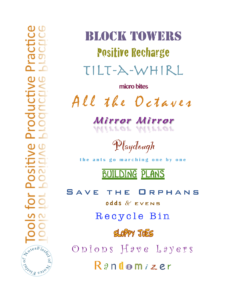IKEA Practicing: 5 Steps To Improve Learning
 Can the way you put together a piece of IKEA furniture say something about the way you might approach other tasks? L J Sedgwick thinks so and advocates using the IKEA process as a way to organize writing in How to Avoid Writing Boring Outlines using the IKEA Method.
Can the way you put together a piece of IKEA furniture say something about the way you might approach other tasks? L J Sedgwick thinks so and advocates using the IKEA process as a way to organize writing in How to Avoid Writing Boring Outlines using the IKEA Method.
Of course, my brain immediately asked, “How can I apply this to music?.” So, here is my own take on an IKEA approach for learning music and practicing it, with apologies to L J. Enjoy!
1. Dump out all your parts
The forest. Just get it all out there. Dump it all out on the floor, the bed, a table. Read through the piece. Guess. Get the big picture. Listen to recordings. We don’t need to follow no stinkin’ directions. Yet…
2. Organize the parts
Look at the score more closely. Figure out what is the same. Use your ears, eyes, and heart. Group things. Separate small tasks into steps. Divide the piece into workable, logical sections. Stop guessing. Put all the things that you need for Part A together. Figure out rough fingerings. Circle the markings that will need attention. Repeat for all sections. For goodness sakes mark up your score—in pencil, of course. If you absolutely need to keep your original score pristine, make a copy and mark that up. If you are working on a tablet, use a score reader that has annotation capability.
3. Start assembling the groups of parts
Use your instruction manual—the printed score with your added markings. Working in small sections, put A together. Put B together. Put… You get the idea. Roll up your sleeves and get your hands really dirty. Solve technical and musical problems. Refine fingerings. This is where a lot of people think that practicing starts, but, without steps 1 and 2 your efforts can be both awkward and random resulting in frustration and disappointment.
4. Add assembled groups together into a whole
Take your shorter sections and assemble them into much larger sections. Put the back on. Slide in the drawers. Screw in the legs. Take those larger sections and assemble them into a whole piece that has a high point and a logical beginning, middle, and end. Double check your instruction manual—aka the score—to be sure that there are no extra parts that don’t fit. Listen to more recordings. Tighten the screws. Add the handles. Make sure it’s level.
5. Fit your piece into the room
Create an interpretation that fits with your own understanding and life experience. Add personal items—a throw, a photograph, a vase of flowers. Connect it into your life. Connect your life to it. You just might need to rearrange the furniture to make it fit into your world.
 For proven practice strategies to use as you apply these 5 steps, check out my Tools for Positive Practice
For proven practice strategies to use as you apply these 5 steps, check out my Tools for Positive Practice


